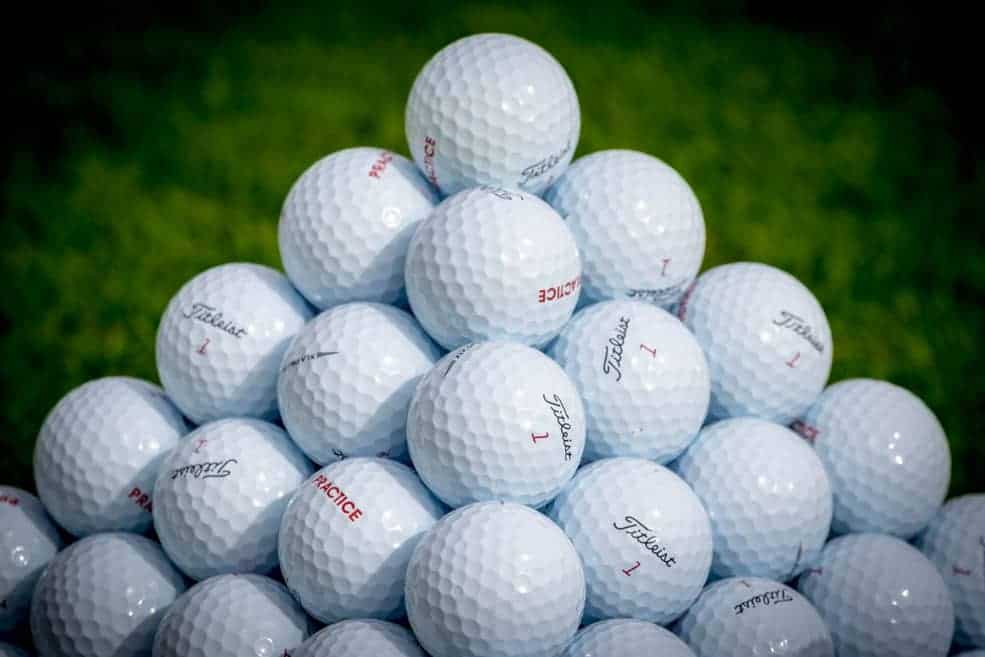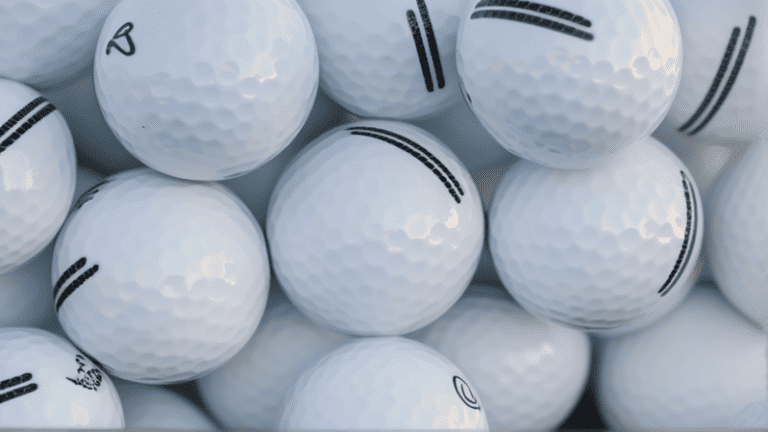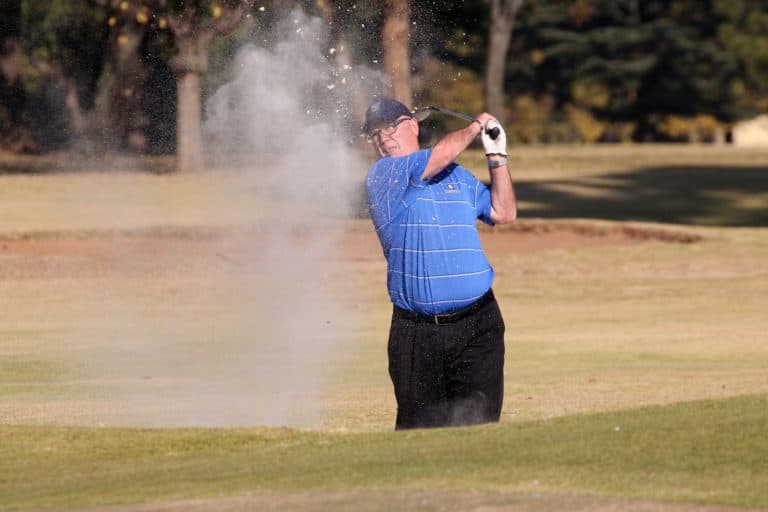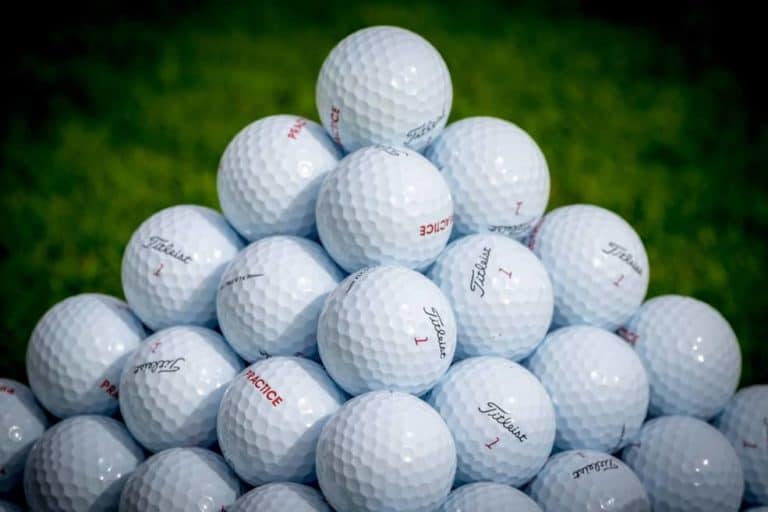How Many Dimples Are On A Golf Ball? 1 Genius Patent That Changed The Game
If you’re a golf enthusiast, you’ve likely asked yourself this question, “How many dimples are on a golf ball?” Well, you’re in luck! Today, we are going “under the cover” literally, of a golf ball to answer this question and more.
So, how many dimples are on a golf ball?
The short answer is: typically between 300 and 500. However, it can vary based on the ball manufacturer and design.
Why Do Golf Balls Have Dimples?
Surprisingly, these small indentations aid ball performance. They generate lift and reduce air drag, enabling the ball to travel further. Imagine trying to throw a flat stone; it won’t go far, would it? That’s the theory behind dimpled golf balls.
It’s all about the aerodynamics.
When a golf ball is hit and launched into the air, air flows around the ball. The shape of the ball and the pattern of dimples on its surface can greatly affect the airflow around the ball.
Dimples on a golf ball create turbulence in the boundary layer, which is the thin layer of air against the surface of the ball. The turbulence caused by the dimples reduces air drag, enabling the ball to fly further than a smooth ball.
In simpler terms, the dimples on a golf ball work to reduce the air resistance that slows the ball down, allowing it to travel at a higher speed for a greater distance. Without dimples on the golf ball, it could not travel half as far as it does.
So, while they might seem like just a small design detail, how many dimples are on a golf ball plays an incredibly important role in the game of golf!
For the beginner golfer, the dimples are a welcome ally as they learn the game.
What Would Happen If Played A Round With Dimpless Golf Balls?
Without dimples, your ball could not gain the same height, fly as far, be controlled, or fly as consistently.
Distance: it’s been estimated that the ball might travel only half as far. For a golfer who needs to cover a lot of ground with each shot, this is a crucial factor. A smooth ball experiences more air pressure in front and creates a larger wake behind, which results in greater drag and less flight distance.
Trajectory: The dimples also influence the trajectory, or flight path, of the ball. They do this by generating lift, much like the wings on an airplane. This lift helps the ball ascend after being hit and maintains its flight for longer. A smooth ball without dimples wouldn’t generate as much lift, causing the ball to drop to the ground more quickly. It would also be more affected by gravity, limiting its ability to maintain a steady flight.
Control: The way dimples are arranged on a golf ball, known as the dimple pattern, can also affect how the ball spins when hit. This spin is what gives golfers the ability to curve their shots, adding control and finesse to their game. Different golf balls come with different dimple patterns designed to optimize spin rate, direction, and speed.
Consistency: The dimples allow the ball to cut through different weather conditions with more consistency. This means even in windy conditions, a golfer can play a ’true’ shot.
So, the dimples on your golf ball play a crucial role in how far and accurately you can hit your ball, enabling you to get into better scoring positions on the golf course. Different dimple counts are suited better to different game styles, swing speeds, and golfing skill levels – making the seemingly simple dimple an extremely important part of your golf game.
When Did Golf Balls Get Dimples?
While early golf balls in the 14th century lacked dimples, it took until the mid-19th century when golfers noticed that their used golf balls, which had scratches and nicks, traveled further than the new, smooth balls.
They concluded that these imperfections reduced air drag and increased the ball’s flight distance.
However, it took some time before these observations led to intentional design changes. The first intentionally designed dimpled golf balls didn’t appear until the early 20th century. The first U.S. patent for a dimpled golf ball was granted in 1905 to English engineer William Taylor.
William Taylor was the first to determine how many dimples are on a golf ball.
Since then, technological advancements and ongoing research have led to the development and refinement of dimple patterns and designs that we see today, all aimed at enhancing lifting force and reducing air drag to maximize a golf ball’s flight distance and control.
The Evolution of How Many Dimples Are on a Golf Ball
Golf ball dimples have evolved over the years, with constant research improving dimple science and its impact on ball flight, from the “Guttie” balls of the 1850s to the technologically advanced balls of today.
William Taylor filed the first patent for a dimpled golf ball in 1905. His design had round dimples, as he had realized these indentations could manipulate the air around the ball during flight to reduce drag and improve lift. William Taylor was the first to decide how many dimples are on a golf ball.
1930s to 1970s: The core change during this period was the transition from wound balls to two-piece balls in the 1960s and 1970s. Dimple designs remained largely spherical and uniform, but the interiors saw significant changes, improving energy transfer and reducing spin.
The 80s, 90s, and Beyond: Technological advancements allowed companies to experiment with different dimple shapes, sizes, and patterns. In their persistence to make balls that fly straighter and further, manufacturers started to create balls with dimples inside dimples, hexagonal dimples, asymmetrical dimple patterns, and more.
Today: Today’s golf balls are a product of precision engineering and design, with several brands boasting their unique dimple designs. Now, dimples are not only responsible for decreasing drag and increasing lift, but they also have intricate designs aimed at controlling ball trajectory, reducing hooks and slices, and maximizing stability in windy conditions.
How Big Are Dimples on Golf Balls?
Dimple dimensions vary, but they generally measure about 0.010 inches in depth.
How Much Does a Golf Ball Weigh?
The United States Golf Association dictates that a golf ball should not weigh more than 1.620 ounces (45.93 grams). The numbers do vary. For instance, the Bridgestone e12 Contact weighs in at just over 1.3 ounces, and the Titleist Pro V1 at 1.61. Though it may slightly affect ball flight, the average golfer is not likely to notice.
How Big Is a Golf Ball?
Golf balls have a diameter of not less than 1.680 inches (42.67 mm).
How Do I Know Which Golf Ball Dimple Pattern Is Right for Me?
Selecting a ball chiefly depends on your skill level and playing style. Low-handicap players may prefer balls that offer more control and will choose higher compression-level balls with three plus layers. High-handicap players often opt for balls with lower compression and fewer layers that will reduce errant shots..
What is the Ideal Dimple Range on a Golf Ball?
This depends on the golfer’s preference and playing conditions; however, most golf balls feature between 300 and 500 dimples.
Which Golf Balls Have the Most Dimples?
Brands like Pinnacle and Titleist have a high dimple count with 392 and 352 dimples respectively.
Different Dimple Patterns and Dimple Counts by Brands
Dimple patterns are unique to the brand, with most patterns being either spherical or tetrahedral.
- Maxfli U/2 Model Golf Ball 422.00
- Maxfli U/3 422.00
- Bridgestone Precept Powerdrive Golf Ball 372.00
- Bridgestone e6 SPEED 330.00
- Callaway HEX Chrome 332.00
- Callaway New Chrome Soft Yellow 332.00
- Callaway Supersoft 332.00
- Nike Power Distance Long 432.00
- Nike Power Distance Soft 314.00
- Pinnacle Rush 332.00
- Pinnacle Soft 332.00
- Slazenger RAW Distance Feel 402.00
- Slazenger RAW Distance 428.00
- Snell Golf MTB Red 338.00
- Snell MTB-X 360.00
- Srixon Q-STAR 344.00
- Srixon Soft Feel 324.00
- Srixon Z-STAR 344.00
- TaylorMade Burner 342.00
- TaylorMade New Tour Response 322.00
- TaylorMade Soft Response 322.00
- Taylormade Distance 342.00
- TaylorMade Noodle Long and Soft 342.00
- Titleist DT TruSoft 376.00
- Titleist Tour Soft 342.00
- Titleist’s 2020 TruFeel 376.00
- Titleist ProV1 352.00
- Titleist ProV1 RCT 388.00
- Titleist DT Trusoft 376.00
- Top-Flite D2+ Straight 332.00
- Vice Pro Soft Golf Ball 336.00
- Vice Pro Golf Ball 318.00
- Volvik Crystal 350.00
- Volvik Vivid Golf Ball 322.00
Conclusion
The humble dimple plays a crucial role in the game of golf. From developing increased lift and reduced drag to facilitate longer shots, to contributing to consistent performance in varying weather conditions, these seemingly simple indentations are paramount to the game.
That ‘simple’ golf ball sitting in your bag is a product of centuries of history and considerable engineering advances.
Next time you tee off, remember how that ball’s 300 to 500 dimples, each around 0.010 inches, are working together to help you play your perfect shot. Whether you are a weekend warrior or an aspiring pro, it’s crucial to understand that the intricate details of dimple design are a potential key to improving your game. Maybe the answer to shaving off those few extra strokes lies within the dimples on your golf ball!







